With the right technique, cut and de-seeding a pomegranate can be both easy and mess-free. This guide will walk you through the best methods for how to cut and de-seed a pomegranate, ensuring you extract every last pomegranate seed with minimal effort and maximum reward.
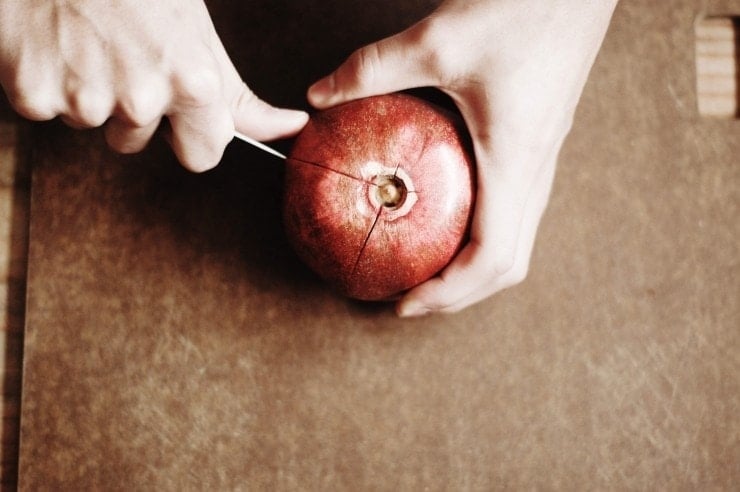
Pomegranates, with their vibrant ruby-red seeds and sweet-tart flavor, are a true gift from Mother Nature. But let’s be honest—extracting those coveted jewel-like arils can be somewhat intimidating. If you’ve ever found yourself in a standoff with a pomegranate, unsure of how to proceed without turning your kitchen into a crimson-splattered crime scene, you’re not alone here.
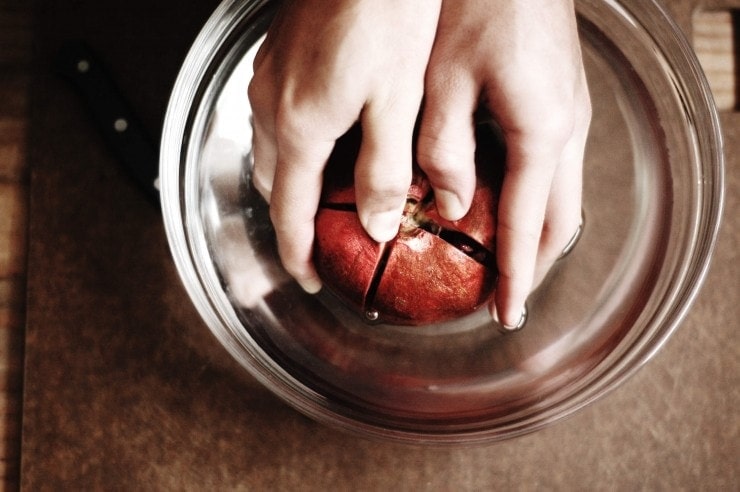
How Do You Eat Pomegranates?
Pomegranates are delightfully versatile, making them a joy to have on their own or to incorporate into different dishes and snacks. You can enjoy the seeds (also known as arils) straight from the fruit, savoring their juicy burst as a healthy, refreshing snack. They’re equally delightful sprinkled over salads, stirred into yogurt or oatmeal, or used to add a pop of color and crunch to desserts like a Pavlova. If you’re feeling creative, blend them into smoothies or use them as a garnish for both sweet and savory dishes.
These ancient fruits, revered for centuries, are not only delicious but packed with nutrients and are believed to boost heart health according to the American Heart Association. Rich in antioxidants, fiber, vitamins C and K, and potassium, pomegranate seeds add a burst of flavor and nutrition to a wide variety of dishes.
The Best Time to Buy Pomegranates
Pomegranate season typically runs from September through January, with the peak time being in autumn. When choosing pomegranates, look for ones that feel heavy for their size—this indicates a juicy interior. Opt for pomegranates with a vibrant, red skin, free of major blemished or soft spots. Avoid those with a dull, brownish hue, and shriveled texture–– signs of fruit that has lost its luster.
Tools You’ll Need to De-Seed A Pomegranate
- Sharp knife
- Cutting board
- Large bowl
- Water (optional)
- Heavy spoon (can be metal or wood)
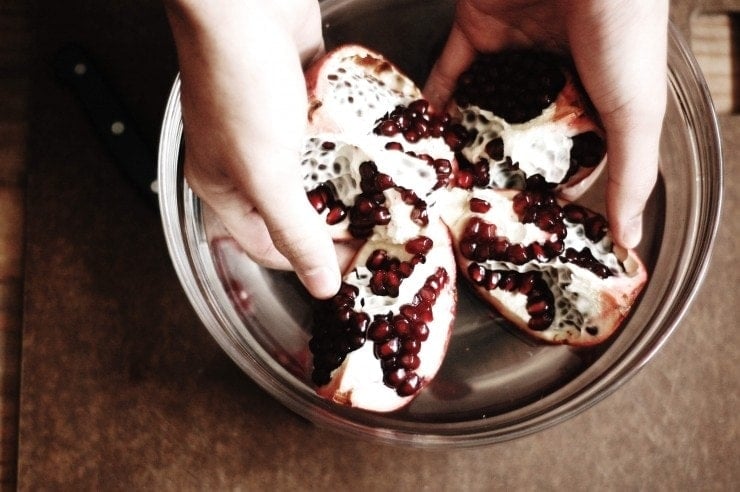
Method 1: The Traditional Water Bath Technique (My Go-To)
There are plenty of methods to cut and de-seed a pomegranate, but this one is my go-to. It’s a simple, effective way to ensure you get every last juicy seed without any bruising. If you’re looking to keep your kitchen mess-free, this is the best technique to peel and de-seed pomegranates. It’s quick, easy, and will save your favorite shirt from any unwanted stains.
- Cut and Score the Pomegranate: Fill a large bowl with cold water; then, slice the small crown off the top of the pomegranate. After the crown is sliced off, begin to score the skin of the fruit from top to bottom into four equal parts. Try to only cut into the skin, and not into the seeds (if some juice comes out, that is okay).
- Submerge and Separate: Place the scored pomegranate into the bowl of cold water. This is what will prevent stains from happening all over your cooking surfaces and clothing. Proceed to separate each section under the water.
- Remove the Seeds: Working with one section, (under the water) using your thumb, gently but firmly loosen the seeds from the membrane. Repeat with each section.
- Clean and Store: Ensure you have a bowl on the side so you can toss away any pomegranate membrane– the foamy white pith from the fruit is not meant to be eaten. All of the pith should float to the top and the seeds should will generally stay at the bottom of the bowl. Skim off any white pith from the bowl of water with your fingers or a metal spoon. Place the seeds in a colander, and wash them under cold water before eating. Pat the seeds dry with a clean kitchen towel or paper towel and store them in an airtight container in the refrigerator for up to five days.
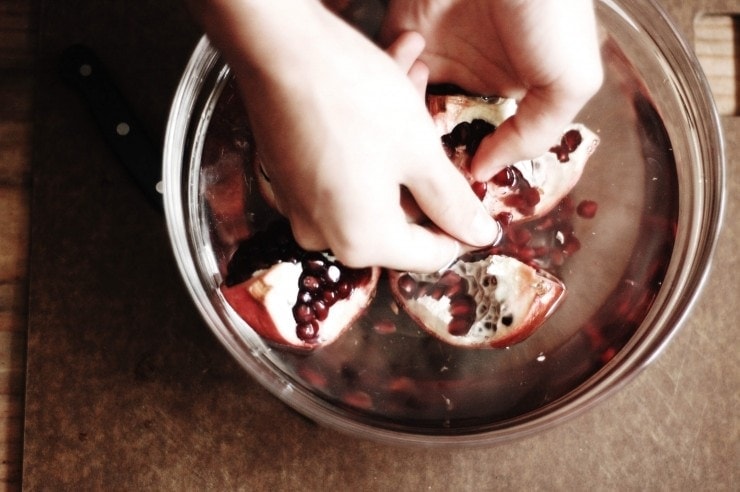
Method 2: The Easy Cut & Pry Technique
For those who want a bit more control and prefer a dry method of peeling and de-seeding pomegranates, this cut & pry technique is a good choice. There is no promise it will keep your kitchen (or your clothing) mess-free, but it is perfect for those who prefer a controlled approach without compromising on the ease of extracting those precious arils. It is important to note: do not wear white or light-colored clothing, and be firm but gentle when loosening the pomegranate seeds from the skin. It’s advisable to do this in a bowl placed in a clean sink to prevent any pomegranate arils from flying across the room.
- Top and Score: Cut off the crown and make shallow, lengthwise cuts along the ridges of the pomegranate (usually four to six, depending on the fruit).
- Open and Pry: Gently pry open the pomegranate into sections using your hands. The pomegranate should naturally split along the scored lines, exposing the seeds with minimal mess.
- Release the Seeds: Carefully run your thumb along the seeds to release them into a large bowl. Remove any bits of foamy white pith that fall in.
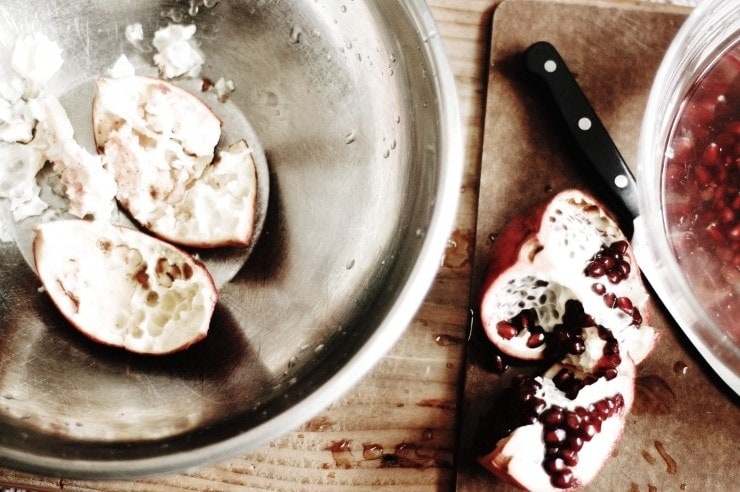
Method 3: The Spoon Method
If you’re short on time and don’t mind a bit of juice splatter, the spoon whacking method is your go-to. This technique is great when you need pomegranate seeds in a hurry. It’s highly advised to not wear anything you’re worried about staining when utilizing this method as it can be quite a bit messy. I especially recommend doing this over a bowl, in a clean sink.
- Halve the Pomegranate: Begin by slicing the pomegranate in half horizontally.
- Whack Away: Hold one half of the pomegranate over a bowl, seed side down. I place the bowl in a clean sink as an extra way to avoid any mess. Using the back of a wooden or metal spoon, firmly and confidently whack the pomegranate’s outer skin. The seeds should start falling into the bowl. Rotate the pomegranate and continue hitting it with the spoon until all the seeds are released.
- Pick and Store: Remove any stubborn seeds with your fingers and discard the foamy white pith. Store the seeds as previously mentioned in Method 1.
Tips and Tricks
- Room Temperature: Pomegranates are easier to handle at room temperature. If yours is cold, let it sit out for a bit before you start.
- Avoid Juice Stains: Pomegranate juice can stain clothes and countertops. To avoid this, wear an apron and consider laying down a kitchen towel or plastic wrap on your work surface. You may want to also consider peeling and de-seeding your pomegranates in a large bowl placed in a clean sink– this will act as an extra later of precaution from pomegranate arils that could go flying across the room.
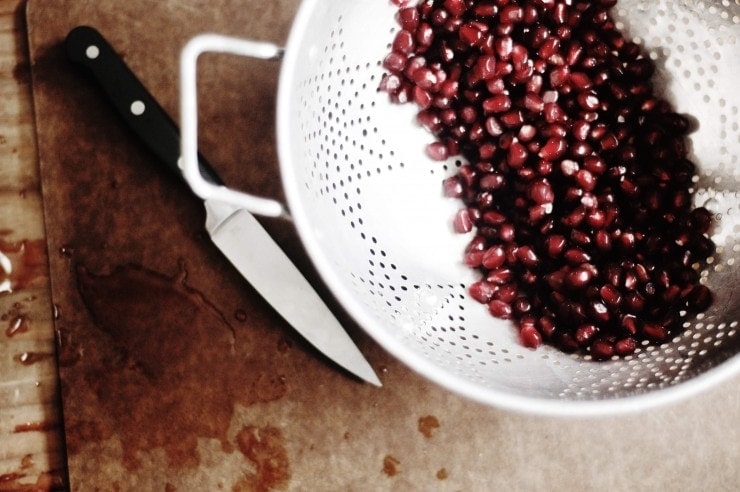
How to Use Pomegranate Seeds
Now that you’ve successfully extracted the pomegranate seeds, what can you do with them? The possibilities are endless. Toss them into salads for a pop of color and crunch, sprinkle them over yogurt or oatmeal, blend them into smoothies, or use them as a garnish for desserts like these Easy Fig Tarts. You can even use the seeds to make fresh pomegranate juice or pomegranate molasses, which is used heavily in Persian and Middle-Eastern cuisines.
Frequently Asked Questions (FAQ)
How do I know if a pomegranate is ripe?
Ripe pomegranates have smooth, firm skin and feel heavy for their size. The color should be deep red or maroon.
Can I eat pomegranate seeds whole?
Yes, pomegranate seeds are edible and can be eaten whole. The tiny seeds inside the arils add a delightful crunch.
What’s the best way to store pomegranate seeds?
Pat any wet pomegranate seeds dry with a clean kitchen towel or paper towel. Store the seeds in an airtight container in the refrigerator for up to five days.
Can you freeze pomegranate seeds?
Yes, pomegranate seeds can be frozen for longer storage. To freeze, spread the seeds in a single layer on a baking sheet lined with parchment paper. Place the baking sheet in the freezer until the seeds are solid (about 2 to 4 hours), then transfer them to a freezer-safe bag or airtight container. Frozen pomegranate seeds will keep for up to six months and can be used directly in recipes without thawing.
With these easy methods, peeling and de-seeding a pomegranate is a breeze. Armed with this knowledge, you’ll never shy away from these delightful fruits again. Whether you’re adding them to your favorite dishes or enjoying them as a snack, pomegranate seeds are well worth the effort.
Other Posts You Will Enjoy
Check out our How-To archives for more posts like this one! Or check out one of the following posts:
How to De-Seed a Pomegranate

Pomegranates are so satisfying, but they can be a hassle to de-seed and cut. Here's how to cut and de-seed a pomegranate the easy way. The best part is: it will leave your hands and favorite shirt stain-free of pomegranate juice and mess, and it doesn't take much time to do!
Pomegranates can be quite expensive, and I like to take care with preparing them properly. I'm not from the school of neatly cutting down into the entire pomegranate. When I cut and de-seed pomegranates, the cold water method of deseeding is the the one I always go to. There's no need to worry about bruised pomegranate seeds or food waste.
One alternative method involves slicing a pomegranate in half. After that, each half of the pomegranate is placed with the seed-side facing a large bowl. The back of the pomegranate is hit firmly with a spoon (metal or wood– whichever seems most effective). However, that method is a bit messy and results in too many bruised pomegranate seeds.
Ingredients
- 1 Pomegranate
- Cold Water
Instructions
- Fill a large bowl with cold water; then, slice the small crown off the top of the pomegranate. You should be left with something that looks like the picture below. After the crown is sliced off, begin to score the skin of the fruit into four equal parts. Be sure only to cut into the skin, and not into the seeds (if you do and a little juice comes out, that’s okay)
- Place the scored pomegranate into the bowl of cold water.
- Proceed to separate each section under the water.
- Working with one section, (under the water) using your thumb, gently but firmly loosen the seeds from the membrane. Repeat with each section.
- Be sure to have a bowl to the side, so you can toss away any membrane– the white pith from the pomegranate- it’s not appetizing. All of the pith should float to the top and the seeds should stay at the bottom of the bowl. Skim off any white pith from the bowl of water.
- Place the seeds in a colander, give them a quick wash under cold water, and enjoy!
Notes
Storage: The seeds should keep for a couple of days in an airtight container placed in the refrigerator.
Nutrition Information:
Yield:
1Serving Size:
1Amount Per Serving: Calories: 83Total Fat: 1gSaturated Fat: 0gTrans Fat: 0gUnsaturated Fat: 0gCholesterol: 0mgSodium: 3mgCarbohydrates: 19gFiber: 4gSugar: 14gProtein: 2g
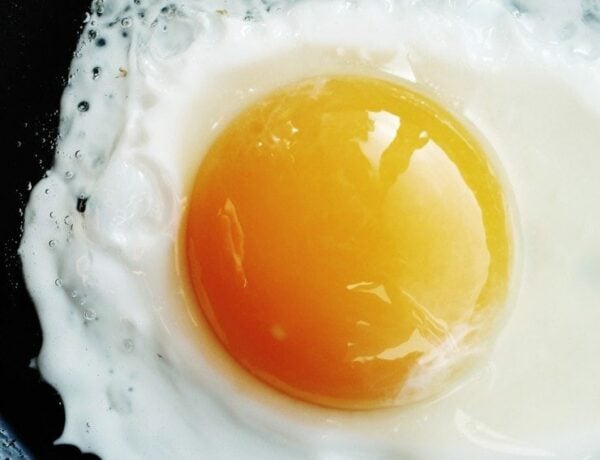
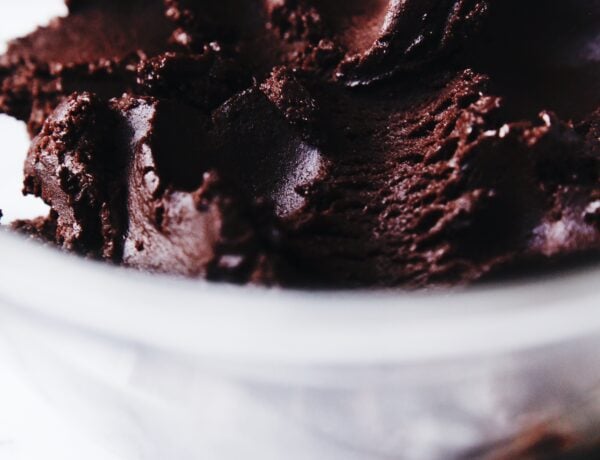

1 Comment
Naseem
April 30, 2016 at 12:19 amDid just as you wrote today! Lucky to get my hands on a couple gorgeous pomegranates….. Usually very hesitant to buy them because of the mess. I love this water method. Doesnt ruin the seeds Ike the spoon methods do and I think the spoons one is a huge mess.